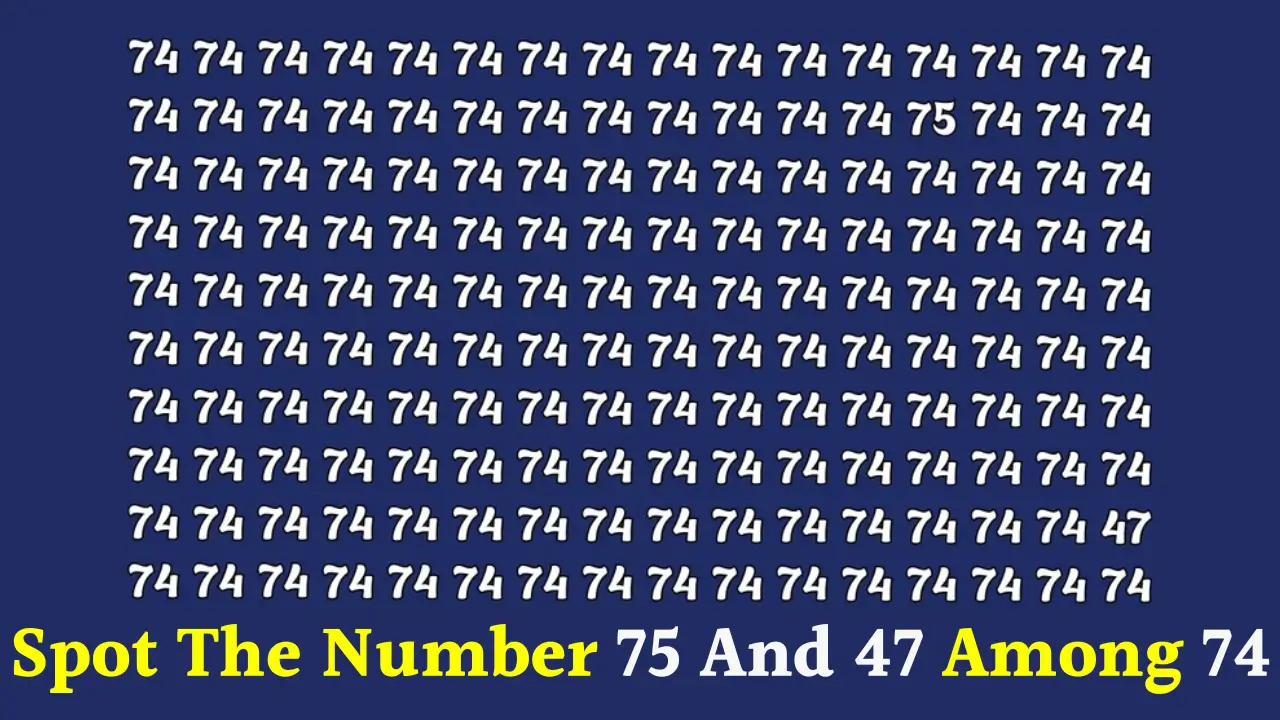Optical illusions have fascinated scientists, psychologists, and the general public for centuries. They challenge our perception, trick our eyesight, and reveal how the human brain interprets patterns differently from reality. In recent years, number-based optical illusion puzzles have become increasingly popular on social media platforms.
One such challenge that has been making its rounds is the intriguing puzzle: Spot the number 75 and 47 hidden among the number 74. This illusion is a blend of entertainment and cognitive exercise. At first glance, the puzzle seems overwhelmingly filled with repeating digits, usually 74 in this case.
However, hidden discreetly within this sea of numbers are two distinct numbers, 75 and 47, that test the sharpness of your observation.
Why Number Optical Illusions are Unique?
Unlike classic optical illusions involving shapes or imagery, number illusions appeal to logical reasoning and pattern recognition. They are not only engaging, but they also push the brain to work harder, enhancing concentration and memory. Such puzzles are widely used in cognitive training exercises to strengthen ocular focus and mental agility.
When you’re asked to find 75 and 47 among repeated 74s, your brain instinctively tries to form a pattern, ignoring small variations. This is why spotting the hidden numbers becomes challenging at first glance.
The Challenge: Spot the Number 75 and 47 Among 74
The puzzle presents a grid or cluster of repeating numbers, usually 74, arranged closely without much spacing. Hidden within this grid are the numbers 75 and 47. At first, the digits may seem almost invisible as the eyes scan through the rows of 74. However, careful observation and a systematic search reveal the hidden pattern.
This task is more than just fun—it actively tests visual perception and helps understand how recognition speed differs among individuals.
Tips to Spot the Hidden Numbers
Although the puzzle seems tricky, there are strategies that make spotting the hidden numbers easier. First, avoid rushing. Slow scanning from left to right or top to bottom usually helps. Instead of skimming quickly, focus on each pair of numbers one by one, which prevents your brain from automatically registering every digit as 74.
Importance of Pattern Recognition in Brain Training
Pattern recognition plays a major role in solving such visual challenges. The human brain tends to form shortcuts, grouping familiar elements together, which is why we often misinterpret slightly different numbers as the repeated sequence.
By regularly engaging in such puzzles, individuals can improve their:
- Attention to fine detail
- Ability to separate irregularities from similarities
- Concentration and observation skills
How the Brain Perceives Numbers in Optical Illusions?
When you first attempt a number illusion, the repeated pattern dominates your vision. The brain begins ignoring variations due to something called perceptual set. This psychological tendency causes people to perceive things based on expectations or habitual recognition.
For example, when most of the grid shows 74, the brain becomes conditioned to expect more of the same. This creates difficulty in identifying 75 or 47 immediately. Only upon focused visual scanning do these unique numbers reveal themselves.
Why 75 and 47 Are Hard to Spot Among 74?
The difficulty lies in the similarity. Numbers 74, 75, and 47 are close enough in structure that they can be easily misread, especially when packed tightly in rows. The digit “7” is constant in all three numbers, making the variances subtle. Eyes often blur these small differences because of the surrounding repetition.
Number Illusions in Daily Life
Interestingly, number-based illusions are not just puzzles. They mimic real-life scenarios where attention to detail matters. For instance:
- Accountants or clerks scanning rows of financial data need to spot errors among repeated values.
- Students double-checking calculations rely on similar concentration skills.
- Professionals in quality control must identify defects hidden within repetitive patterns.
This shows that number optical illusions are more than just games—they are training tools that simulate practical skills.
Comparative Example of Hidden Numbers
To further understand how these puzzles work, here is a simple comparison showing why spotting 75 and 47 among 74 is tough:
| Number | Similarity to 74 | Possible Confusion Factor |
|---|---|---|
| 74 | Base repeated number | None – the repeated pattern |
| 75 | Only the last digit differs | Eye can confuse “5” with “4” when scanning quickly |
| 47 | Digits reversed | Brain quickly assumes “74” due to repetition dominance |
This table highlights why players often overlook the hidden numbers at first glance.
Social Media Craze and Popularity
Number-based optical illusions have become a trend worldwide. Shared widely on platforms like Instagram and Facebook, they invite people to test their observation speed and compare results with friends. Some puzzles even include a timer challenge where participants must locate the hidden digits within a few seconds. This social element adds a sense of competition and fun while engaging the brain.
Benefits of Solving Number Optical Illusions
Number puzzles like spotting 75 and 47 among 74 hold several benefits:
- Improves visual sharpness and focus
- Enhances short-term memory
- Encourages problem-solving under visual pressure
- Relieves stress by offering a fun cognitive break
Such small and engaging challenges are considered micro brain workouts, especially useful for both younger learners and older adults.
Detailed Observation Techniques
If you attempt to spot the hidden 75 and 47, adopting the following techniques can help:
- Scan the digits methodically row by row instead of randomly.
- Use your finger or cursor to guide your eyesight down each column.
- Break the cluster into smaller sections mentally and examine one section at a time.
- Take a step back from the screen or grid and glance again. A different viewing distance often reveals hidden discrepancies.
FAQs
Q1. Why is it difficult to spot 75 and 47 among 74?
Because of the brain’s tendency to expect the repeated number, small variations like 75 and 47 are often overlooked.
Q2. How can I improve at solving number optical illusions?
Practice slowing down observation, scanning methodically, and honing attention to subtle differences.
Q3. Do number optical illusions help improve brain function?
Yes, they train the brain to recognise irregular patterns, enhancing focus and problem-solving abilities.
Q4. Is there a time limit to solve illusions like finding 75 and 47 among 74?
Some puzzles add a timer for fun, but generally, there is no strict time limit unless used in a challenge setting.
Q5. Can children benefit from such illusions?
Absolutely, as they strengthen attention spans and promote early cognitive development without being overly complex.
Conclusion
The optical illusion challenge to spot the number 75 and 47 among 74 is more than just a viral trend—it is a fascinating glimpse into how the human brain processes visual information. These number puzzles promote concentration, enhance pattern recognition, and engage people in a fun yet educational activity. While they may seem simple at first glance, the hidden difficulty offers both entertainment and cognitive benefits, making them a worthwhile exercise for all ages.


















